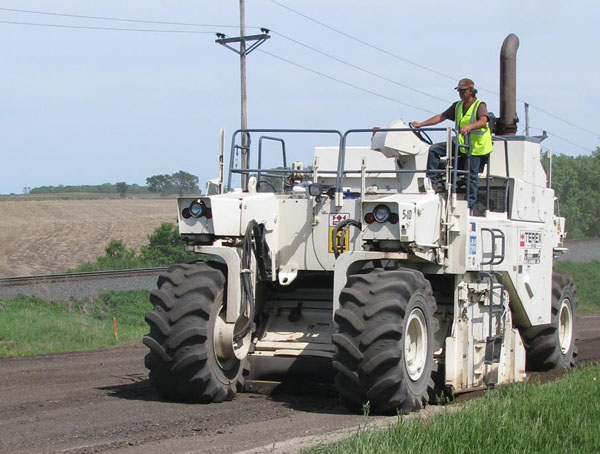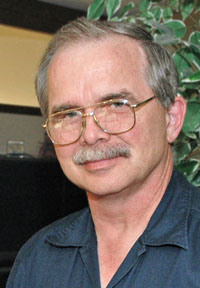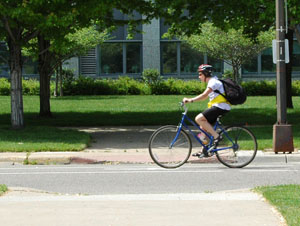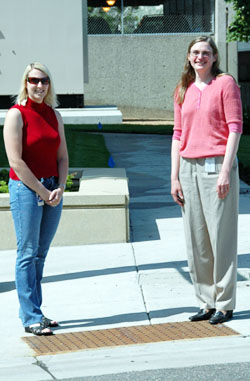 |
|

|
 |
TABLE of CONTENTS
 |
Pavement reclamation makes Hwy 55 rehabilitation more green, cost efficient |
By Angela Mathis

A contractor employee reclaims existing pavement on Hwy 55 east of Kensington in District 4. Photo by Dana Hanson |
“Going green” brings to mind alternative energy, resource conservation, reusable water bottles and grocery bags—but a method of road construction? Although people typically do not associate these two concepts, Mn/DOT brings them together in the Hwy 55 project in District 4/Glenwood.
This $8.1 million project, which is replacing a bridge and culverts, and reconstructing the road between the Grant/Douglas county line and Hwy 28 junction, is using a process called pavement reclamation. Reclamation allows old pavement to be recycled on site, laying the foundation for new road.
Upon completion in September, the new Hwy 55 will provide a safer roadway with better conditions.
“A smoother road and the addition of rumble strips to prevent off-the-road accidents are just two of the many project benefits,” said Dan Kuhn, project manager. “Moreover, increasing the waterway opening and placing rock boulders on the in-slope adjacent to the abutments for the new bridge spanning the Chippewa River will prevent erosion problems from recurring.”
Kuhn said that crews also will add rock boulders and “stream barbs,” under the bridge to slow and redirect water, preventing future erosion and stabilizing the stream bank.
In addition to these benefits, the Hwy 55 project involves pavement reclamation, a process where a machine is used to grind up existing pavement and leave behind a layer of material that forms the base of the new road. The Office of Materials and Road Research obtained the $200,000 funding of the test sections through the Destination Innovation Fund.
“Pavement reclamation provides the benefits of a brand-new road without the cost of a total regrade,” he said.
While all 22.6 miles of road will be reclaimed, four miles serve as a research study. The first mile is a control strip. Each of the other three one-mile segments has a thinner surface of new pavement and a different type of oil added to the base layer to strengthen it.
“This test section is a technological showcase for Mn/DOT staff,” said Steve Adamsky, Materials and Road Research. “Districts can learn from it and incorporate pavement reclamation into their rehabilitation schedule.”
Other states using the process have estimated that reclaiming old pavement reduces costs by 30 percent, according to Adamsky.
“All the material is left in one place so you don’t have to pick it up, crush it and take it back to the site,” he said. “There are cost and time savings to this process.”
The process also results in longer-lasting roads.
“When old, cracked roads are resurfaced, the cracks tend to reappear on the new surface over time,” Adamsky said. “Pavement reclamation literally breaks up this pattern of cracking pavement, ensuring better road conditions for drivers.” |
 |
|

|
 |
TABLE of CONTENTS
 |
Illness claims life of facility management's Lester Schwarting |

Lester Schwarting, Central Office Facility Management, worked at Mn/DOT for 22 years. Photo by David Gonzalez |
Lester Schwarting, Central Office Facility Management, died May 27. He was 61 years old.
Schwarting worked at Mn/DOT for 22 years. Last year, he was diagnosed with Parkinson’s disease and Hodgkin’s Lymphoma Cancer.
“We will all miss Lester’s deep hearty laughter whenever he would share a humor tidbit with us in the office,” said Bob Vang, Central Office facility manager. “Les was a perfectionist and enjoyed doing his job well. He enjoyed making people happy. He will be deeply missed by all who had the honor of knowing him.”
Schwarting’s is survived by his wife Darlene, four children, five grandchildren, mother and four siblings.
Funeral services were held June 2 at Faith Lutheran in St. Paul. |
 |
|

|
 |
TABLE of CONTENTS
 |
New law requires quick removal of crash debris from Metro District roadways |
|
By Erik Rudeen, Government Affairs
On May 15, Gov. Tim Pawlenty signed a bill allowing Mn/DOT—in conjunction with the Minnesota State Patrol and private recovery companies—the ability to quickly clear traffic lanes after a crash. Effective Aug. 1, the law only applies in Mn/DOT’s eight-county Metro District.
Under provisions of the new law, vehicles and cargo can be pulled, pushed or dragged out of the way in order to open traffic lanes and remove the traffic hazard. All available resources will be used to quickly clear incidents following collisions or spilled loads.
Although the State Patrol was fully supportive of this initiative, the Minnesota Trucking Association had serious concerns about it for several years. Mn/DOT worked with the MTA, tow truck companies and the insurance industry to finally get this proposal enacted this year.
Crashes, rollovers or jack-knifed commercial vehicles with spilled loads often block lanes of traffic for several hours before they are cleared. One of the challenges in clearing spilled cargo is removing it from the roadway without causing additional damage. This is a time-consuming process.
With passage of the new law, recovery companies will be required to quickly clear the road so that travel lanes can be opened as quickly as possible. If there are issues with cargo damage claims, they can be settled later between the recovery company and the trucking company.
“Mn/DOT is committed to working with all parties to improve incident response and clearance time,” said Amr Jabr, Metro District director of operations and maintenance. “This new law will provide an important tool as we continue working on efforts to increase mobility in the metro area. It will ease congestion, reduce commute times, decrease the possibility of secondary crashes and improve the quality of life and economic well-being of all Minnesotans.”
For more information about this law and a summary of the 2010 legislative session, visit http://ihub.dot.state.mn.us/governmentaffairs/legislative2010/finalsummary/2010yearend.pdf. |
 |
|

|
 |
TABLE of CONTENTS
 |
Minnesota ranks fourth in nation as bike friendly state |
By Donna Lindberg

The League of American Bicyclists recently named Minnesota the fourth most bicycle friendly state in the nation. Photo by Lisa Yang |
The League of American Bicyclists recently announced that Minnesota has been named the fourth most bicycle friendly state in the nation—up from the number five slot that the state held in both 2008 and 2009.
“Improving and expanding bicycling route options for commuter and recreational bicyclists provides a safe, efficient and enjoyable experience for everyone,” said Commissioner Tom Sorel.
This is the third year that the League of American Bicyclists has awarded Bicycle Friendly State designations. The awards announcement coincides with preparations for Minnesota’s Bike/Walk Week activities June 5–11—dates set aside to encourage bicycling as a healthy, environmentally friendly transportation alternative for commuting to work or school and safe bike riding in general.
“Many events have been planned throughout the state during Minnesota Bike/Walk Week,” said Tim Mitchell, state bicycle and pedestrian coordinator. “Check Mn/DOT's Web site http://www.dot.state.mn.us/bike/ for more information about events planned in St. Cloud, Rochester, Duluth and the Twin Cities metro area.”
Minnesota improved its ranking due to several factors:
- Formation of the Bicycle Alliance of Minnesota, a new statewide bicycle advocacy group that helped increase the number of certified bicycle instructors from five to more than 50 last year.
- Creation of partnerships with the city of Minneapolis, the University of Minnesota Parking Services, the Humphrey Institute research staff, Transit for Livable Communities and many other entities in an effort to conduct traffic counts for bicycles.
- Creation of "Share the Road." For five years, this nationally recognized bicycle safety education campaign has helped improve awareness of bicycle laws by both motorists and bicyclists.
- Development of Complete Streets policies by many organizations and communities across Minnesota.
To learn more about the League’s Bicycle Friendly State program, visit http://www.bikeleague.org/programs/bicyclefriendlyamerica/.
Bike or walk to work June 5-11
Bikers of all levels statewide are encouraged to bike or walk to work during Bike/Walk Week June 5–11.
“Events have been planned in many communities and work places throughout the state on June 10,” Mitchell said. “Individuals are also encouraged to ride to work on their own or with a partner that day or anytime during Bike/Walk Week.”
Get Web information about Bike/Walk Week and Day events in:
Twin Cities:
www.bikewalkweek.org
Rochester:
www.rochesterbus.com/bbop/bbop.htm
St. Cloud:
www.stcloudapo.org or call 320-252-7568
Duluth/Superior:
www.ardc.org
For information and tips on how bicyclists and motorists can share the road safely, visit www.sharetheroadmn.org. |
|
 |
|

|
 |
TABLE of CONTENTS
 |
New e-learning program provides risk management overview |
Decision makers around Mn/DOT will now have access to a new program aimed at helping them identify and manage the risks associated with critical project, policy and business-related decisions.
The recently launched e-learning program provides employees with an overview of risk management and is meant to serve as an introduction to the process. It is available on the risk management Web page.
“The program is a valuable addition to any employee’s toolbox.” said Susan Hall, initiative project manager for Policy Analysis, Research & Innovation. “It can be used as a refresher for simple, everyday decision making, and can especially come in handy for those who regularly make decisions and have to look at a lot of different issues with stakeholders.”
Completing the entire interactive program takes about 30 minutes, though employees who want to skip ahead to certain topic areas can do so.
The program is laid out into four topic sections that will teach users how to:
- Identify the characteristics and types of risk
- Define risk management
- Identify common risk management principles and benefits
- Identify the four basic steps of the risk management process
- Identify several uses for risk management
- Obtain assistance in applying risk management
Hall said she hopes the program will serve as an introduction for people who want to learn even more about the benefits associated with the risk management process.
“While the program provides a solid overview of the process, it’s important for employees to know that the Risk Management Team is here to help,” Hall said. “Whether it’s helping with the development of risk management plans for projects or providing consultation, we want employees to take a moment and ask themselves, ‘Is there a way I can use this in my job?’”
In the last year, the Risk Management Team has served in more than 30 consultations and is seeing an increase in demand for future services, which include:
- Evaluating policy decisions
- Jumpstarting project management plans
- Facilitating strategic planning for offices
- Assessing E-magination JAM ideas to see which should go forward
“This process isn’t a fad—we’re not putting this on mugs and handing them out,” said Phil Barnes, Policy Analysis, Research & Innovation assistant director. “Identifying a diverse collection of stakeholder risks early and often is essential to management and collaboration.”
For more information, visit the risk management Web page, or contact Phil Barnes at 651-366-3171. See also, Risk management process brings structure, delivers value to project decisions (Newsline, Dec. 30, 2009). |
 |
|

|
 |
TABLE of CONTENTS
 |
Mark Nelson appointed Statewide Multimodal Planning director |
|
By Angela Mathis

Mark Nelson became the director for the Office of Statewide Multimodal Planning May 2. Photo by Angela Mathis |
Mark B. Nelson officially became the director for the Office of Statewide Multimodal Planning May 27, a role he has filled as acting director since the office formed in February.
The new Office of Statewide Multimodal Planning is responsible for developing a long-term vision for Minnesota’s transportation system and providing planning products, processes and information to support and guide transportation investment decisions.
Nelson said his first big task as director is to “lead the development of a long-term, multimodal vision for Minnesota’s transportation system. This vision will guide subsequent statewide policy and investment plans for all modes,” including highways, transit, bicycles and pedestrian travel, aviation, freight and passenger rail.
“My goal is to elevate multimodal planning within the department. It’s an exciting challenge to take on,” Nelson said.
As a planning director during his four years in the former Office of Investment Management, Nelson worked on the Statewide Transportation Policy Plan and performance measures. He also spent three years as an intelligent transportation systems program manager in the Office of Traffic Safety and Operations.
Prior to joining Mn/DOT, he was a senior consultant with the ITS group at URS Corporation for four years. His other experience includes serving in research positions with Iowa State University and the University of Washington, and as a business systems analyst for the Washington State Department of Transportation.
Nelson received his bachelor’s degree from the University of Minnesota and a master’s degree in Public Administration from The Evergreen State College in Washington State.
Nelson’s office is located on the third floor of Central Office. His phone number is 651-366-3794. |
 |
|

|
 |
TABLE of CONTENTS
 |
Professional license renewals due June 30 |
By Beth Petrowske
Professional licenses for engineers, architects, landscape architects, land surveyors, geologists and other professionals licensed by the Board of Architecture, Engineering, Land Surveying, Landscape Architecture, Geoscience and Interior Design will expire June 30— regardless of when they were first issued.
All professionally licensed Mn/DOT employees are required by law to have a valid license to practice in their field.
Renewals can be completed online at www.aelslagid.state.mn.us or by mail. The Web site is available 24/7, but Board staff are only available weekdays to assist with renewal questions or problems.
When renewing online, applicants will need to enter their professional license or certificate number and the last four digits of their social security number to access their records. Online payment must be made using VISA or MasterCard.
For applicants who wish to renew their licenses by mail, payment must be made by check or money order. The renewal fee is $132.
Applicants must have accumulated at least 24 professional development hours during the last two years to renew their license. This information is required on the renewal forms.
Some Mn/DOT job classes such as Landscape Design Specialist, Land Surveyor Administrative Management and Grad Trainee do not require a Board license. Employees should contact their supervisor or their local Human Resources designee if they are unclear whether or not they need a license. |
 |
|

|
 |
TABLE of CONTENTS
 |
Five productivity tips for Outlook, Office |
By Bob Filipczak
It has been about six months since Mn/DOT switched from GroupWise to Microsoft Outlook and Office. The Office of Information & Technology Services recently put together a list of some of the most common questions employees are still asking:
| How can I search for names in the Mn/DOT address book instead going through the whole Global address list? |
You need to make the Mn/DOT address book your default list by clicking on your address book, choosing Tools and then choosing Options. A box will appear with a field that says “Show this address list first.” Click on DOT and then OK.
|
How can I check my current mailbox size? |
Click on Tools, Mailbox Cleanup and you will see a View Mailbox Size button. Click on the Server Data tab and it will show your mailbox size in kilobytes. Then close everything up.
|
| I used to be able to send vacation requests to my manager in GroupWise. Is there a way to do that in Outlook? |
Create a New Meeting invitation and address it to your manager. In the subject line type your name and “Vacation.” Select the dates you’ll be gone, check the All Day Event box and send the invitation. Right click on that event in your calendar and choose Show Time As and then Out of Office. By default, this will show up as “Free” on your manager’s calendar so it does not look like they are “Busy.”
|
| How do I update old Office files (Word, Excel, Powerpoint) so I can use the new Office features? |
When you have the file open, click on the multi-colored icon in the top left corner. Then, click on Save As and change the type to .docx or .xlsx or .pptx in the Save As drop-down menu. If it’s a Word document, make sure the Maintain Compatibility box is not checked.
Note: The Convert option is available in the Office menu only on computers without EDMS installed.
|
| Why does the new Word program add extra space between paragraphs? |
Microsoft determined that most people put two spaces between paragraphs, so the new program is trying to save some keystrokes. If you want to change it, click on the Home tab and look at the Styles section. See that second box that says No Spacing? Click that.
|
For a full list of common Outlook/Office questions and answers, visit http://ihub.dot.state.mn.us/itweb/oo7upgrade/documents/FAQs%20list.pdf. |
 |
|

|
 |
TABLE of CONTENTS
 |
On the job: Kristie Billiar puts the ADA Transition Plan into action |
By Angela Mathis

Kristie Billiar, Mn/DOT’s ADA implementation coordinator, has worked with pedestrian issues throughout her 14 years at Mn/DOT. Photo by Angela Mathis |
For Kristie Billiar, Mn/DOT’s ADA implementation coordinator, the phrase ‘truncated domes’ is part of everyday vocabulary.
While the term may sound unfamiliar, these ‘small bumps’ are found at many of the 50,000 intersections in Minnesota. Located directly in front of a crosswalk, the domes serve to alert visually impaired people of where the sidewalk ends and the street begins. Placing the domes at intersections is just one way of complying with the Americans with Disabilities Act, which aims to eliminate discrimination against persons with disabilities and ensure they have equal access to jobs and public resources.
Billiar has worked with pedestrian issues throughout her 14 years at Mn/DOT. Before taking the ADA implementation coordinator position 11 months ago, she spent time as both the state’s pedestrian coordinator and the Safe Routes to Schools coordinator.
In her current role, Billiar focuses on policy issues, ADA compliance and implementing infrastructure plans for things like sidewalk improvements, pedestrian signals and curb ramps.
What is something about ADA that many people don’t know or understand?
People may not realize this is not a new law. In fact, the 20th anniversary is this year.
People may also not understand that ADA is a requirement relating to how we need to be doing business. It does not simply encompass infrastructure and employment but is much more far-reaching. Any service provided by Mn/DOT must be accessible. This includes documentation and Web interfaces for people using screen readers to navigate the site as well as providing accommodations for public involvement events.
Another important factor to keep in mind is maintenance of what has already been built. Thinking about the best way to manage pedestrian facilities is the next big challenge because maintaining them is so labor-intensive. It is a complex conversation, but it is clear that building it is not enough.
What has been the most fulfilling part of your job?
Having the ADA Transition Plan completed, even just the first version, has been an accomplishment. Anyone who has been working with it has been asking the right questions, which to me shows that they’ve increased ownership of ADA and their role in enacting the policies.
Another fulfilling part of the job has been getting to know the needs of the community. The external stakeholders group has really evolved as work is done. It’s been gratifying to see them talking about what’s next and how to be effective as advisors—they are really taking on their role.

From left, Michelle Huettl, ADA project manager, and Kristie Billiar, ADA implementation coordinator, stand near a truncated dome. Photo by Angela Mathis |
Has there been positive reception of ADA within Mn/DOT?
Yes. The agency has really focused on design consistency since more awareness has been bubbling up within the past several years. It’s not even a debate of whether or not we should comply with ADA—Mn/DOT has been focused on how to do it effectively.
$2.5 million in economic stimulus funds have been allocated for ADA improvements for FY 2011. What are some of the upcoming projects?
We’re aiming to disperse these funds more evenly across the state to ensure a more equitable distribution. Between this funding and State Road Construction funding, we are looking to complete the inventory for curb ramps by the end of summer. Other projects include curb ramp improvements and design details, accessible pedestrian signals and a pedestrian bridge in St. Cloud.
What are your goals and hopes for the future?
I would like to see ongoing improvements with Mn/DOT because we’re the leader within the state and should continue to assist counties so that ADA policies function as a seamless network for users.
We can also be more attentive to user needs when designing facilities. That way, we can approach policies as a broader concept of what could be done to meet their needs rather than just trying to comply with minimum ADA standards.
Do you or a co-worker have an interesting job to share with readers? Click here to send us your ideas, and we’ll contact you for more information.
Recent employee profiles:
|
 |
|
| |
|



